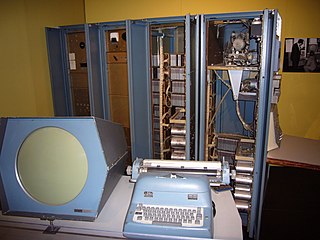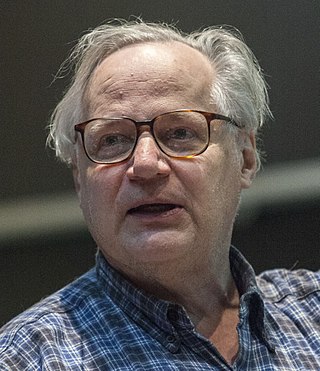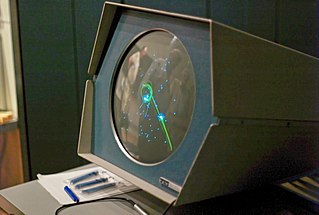Career
The Tech Model Railroad Club
As a member of the Tech Model Railroad Club in his student days at MIT, Samson was noted for his contributions to the Signals and Power Subcommittee, the technical side of the club. Steven Levy's Hackers: Heroes of the Computer Revolution outlines Samson's interest in trains and electronics, and his influence in the club. Levy explains how the club was in fact Samson's gateway into hacking and his ability to manipulate electronics and machine code to create programs. Levy explains how Samson discovered his programming passion with the IBM 704, but frustration with the high level of security around the machine. Only those with very high clearance were able to actually handle the computer, with all programs submitted to be processed through the machine by someone else. This meant Samson would not find out the results of his programs until a few days after submitting them. Because of these restrictions to the IBM 704, it was not until Samson was introduced to the TX-0 that he could explore his obsession with computer programming, as members of the Railroad Club were able to access the computer directly without having to go through a superior. [5]
Dawn of software
Working with Jack Dennis on the TX-0 at MIT Building 26, he developed an interest in computing waveforms to synthesize music. For the PDP-1 he wrote the Harmony Compiler with which PDP-1 users coded music. [6]
He wrote the Expensive Planetarium star display for Spacewar! . [7]
Also for the PDP-1 he wrote TJ-2 (Type Justifying Program), the predecessor of the troff and nroff page layout programs developed at Bell Labs, [8] a War card game, and, with Alan Kotok, T-Square, a drafting program that used a Spacewar! controller for an input device. [9]
Chinese
At Systems Concepts, he programmed the first Chinese-character digital communication system, while he was director of marketing and director of program development. [11]

Programmed Data Processor (PDP), referred to by some customers, media and authors as "Programmable Data Processor," is a term used by the Digital Equipment Corporation from 1957 to 1990 for several lines of minicomputers.

The PDP-1 is the first computer in Digital Equipment Corporation's PDP series and was first produced in 1959. It is famous for being the most important computer in the creation of hacker culture at the Massachusetts Institute of Technology, Bolt, Beranek and Newman and elsewhere. The PDP-1 is the original hardware for playing history's first game on a minicomputer, Steve Russell's Spacewar!

The TX-0, for Transistorized Experimental computer zero, but affectionately referred to as tixo, was an early fully transistorized computer and contained a then-huge 64K of 18-bit words of magnetic-core memory. Construction of the TX-0 began in 1955 and ended in 1956. It was used continually through the 1960s at MIT. The TX-0 incorporated around 3,600 Philco high-frequency surface-barrier transistors, the first transistor suitable for high-speed computers. The TX-0 and its direct descendant, the original PDP-1, were platforms for pioneering computer research and the development of what would later be called computer "hacker" culture. For MIT, this was the first computer to provide a System console which allowed for direct interaction, as opposed to previous computers, which required the use of punched card as a primary interface for programmers debugging their programs. Members of MIT's Tech Model Railroad Club, "the very first hackers at MIT", reveled in the interactivity afforded by the console, and were recruited by Marvin Minsky to work on this and other systems used by Minsky's AI group.
The hacker culture is a subculture of individuals who enjoy—often in collective effort—the intellectual challenge of creatively overcoming the limitations of software systems or electronic hardware, to achieve novel and clever outcomes. The act of engaging in activities in a spirit of playfulness and exploration is termed hacking. However, the defining characteristic of a hacker is not the activities performed themselves, but how it is done and whether it is exciting and meaningful. Activities of playful cleverness can be said to have "hack value" and therefore the term "hacks" came about, with early examples including pranks at MIT done by students to demonstrate their technical aptitude and cleverness. The hacker culture originally emerged in academia in the 1960s around the Massachusetts Institute of Technology (MIT)'s Tech Model Railroad Club (TMRC) and MIT Artificial Intelligence Laboratory. Hacking originally involved entering restricted areas in a clever way without causing any major damage. Some famous hacks at the Massachusetts Institute of Technology were placing of a campus police cruiser on the roof of the Great Dome and converting the Great Dome into R2-D2.

The Tech Model Railroad Club (TMRC) is a student organization at the Massachusetts Institute of Technology (MIT). Historically it has been a wellspring of hacker culture and the oldest such hacking group in North America. Formed in 1946, its HO scale layout specializes in automated operation of model trains.

Hackers: Heroes of the Computer Revolution (ISBN 0-385-19195-2) is a book by Steven Levy about hacker culture. It was published in 1984 in Garden City, New York by Doubleday. Levy describes the people, the machines, and the events that defined the Hacker culture and the Hacker Ethic, from the early mainframe hackers at MIT, to the self-made hardware hackers and game hackers.

Richard D. Greenblatt is an American computer programmer. Along with Bill Gosper, he may be considered to have founded the hacker community, and holds a place of distinction in the communities of the programming language Lisp and of the Massachusetts Institute of Technology (MIT) Artificial Intelligence Laboratory.
Eternal September or the September that never ended is Usenet slang for a period beginning around 1993 when Internet service providers began offering Usenet access to many new users. The flood of new users overwhelmed the existing culture for online forums and the ability to enforce existing norms. AOL followed with their Usenet gateway service in March 1994, leading to a constant stream of new users. Hence, from the early Usenet point of view, the influx of new users in September 1993 never ended.
Stewart Nelson is an American mathematician and programmer from The Bronx who co-founded Systems Concepts.

Alan Kotok was an American computer scientist known for his work at Digital Equipment Corporation and at the World Wide Web Consortium (W3C). Steven Levy, in his book Hackers: Heroes of the Computer Revolution, describes Kotok and his classmates at the Massachusetts Institute of Technology (MIT) as the first true hackers.

Spacewar! is a space combat video game developed in 1962 by Steve Russell in collaboration with Martin Graetz, Wayne Wiitanen, Bob Saunders, Steve Piner, and others. It was written for the newly installed DEC PDP-1 minicomputer at the Massachusetts Institute of Technology. After its initial creation, Spacewar! was expanded further by other students and employees of universities in the area, including Dan Edwards and Peter Samson. It was also spread to many of the few dozen installations of the PDP-1 computer, making Spacewar! the first known video game to be played at multiple computer installations.

TJ-2 was published by Peter Samson in May 1963 and is thought to be the first page layout program. Although it lacks page numbering, page headers and footers, TJ-2 is the first word processor to provide a number of essential typographic alignment and automatic typesetting features:

Expensive Desk Calculator by Robert A. Wagner is thought to be computing's first interactive calculation program.
Expensive Tape Recorder is a digital audio program written by David Gross while a student at the Massachusetts Institute of Technology. Gross developed the idea with Alan Kotok, a fellow member of the Tech Model Railroad Club. The recorder and playback system ran in the late 1950s or early 1960s on MIT's TX-0 computer on loan from Lincoln Laboratory.
Harmony Compiler was written by Peter Samson at the Massachusetts Institute of Technology (MIT). The compiler was designed to encode music for the PDP-1 and built on an earlier program Samson wrote for the TX-0 computer.
T-Square is an early drafting program written by Peter Samson assisted by Alan Kotok and possibly Robert A. Saunders while they were students at the Massachusetts Institute of Technology and members of the Tech Model Railroad Club.
The history of video games spans a period of time between the invention of the first electronic games and today, covering many inventions and developments. Video gaming reached mainstream popularity in the 1970s and 1980s, when arcade video games, gaming consoles and home computer games were introduced to the general public. Since then, video gaming has become a popular form of entertainment and a part of modern culture in most parts of the world. The early history of video games, therefore, covers the period of time between the first interactive electronic game with an electronic display in 1947, the first true video games in the early 1950s, and the rise of early arcade video games in the 1970s. During this time there was a wide range of devices and inventions corresponding with large advances in computing technology, and the actual first video game is dependent on the definition of "video game" used.
The Jargon File is a glossary and usage dictionary of slang used by computer programmers. The original Jargon File was a collection of terms from technical cultures such as the MIT AI Lab, the Stanford AI Lab (SAIL) and others of the old ARPANET AI/LISP/PDP-10 communities, including Bolt, Beranek and Newman, Carnegie Mellon University, and Worcester Polytechnic Institute. It was published in paperback form in 1983 as The Hacker's Dictionary, revised in 1991 as The New Hacker's Dictionary.
David Silver was a student at MIT in the early 1970s, who was the primary developer of the Silver Arm, an improved robotic arm which was used for experimenting in mechanisms for fine motor control using motions similar to human hand and finger movements.
Robert Alan Saunders is an American computer scientist, most famous for being an influential computer programmer. Saunders joined the Tech Model Railroad Club (TMRC) led by Alan Kotok, Peter Samson, and himself. They then met Marvin Minsky and other influential pioneers in what was then known as Artificial Intelligence.








